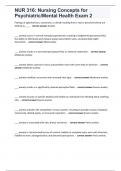NUR 316: Nursing Concepts for
Psychiatric/Mental Health Exam 2
Feelings of apprehension, uneasiness, or dread resulting from a real or perceived threat are
defined as ___. - correct answer Anxiety
___ anxiety occurs in normal everyday experienced, resulting in heightened perceptual field,
the ability to effectively work toward a goal and problem solve, and potentially slight
discomfort. - correct answer Mild anxiety
___ anxiety results in a narrowed perceptual field, or selective inattention. - correct answer
Moderate anxiety
___ anxiety allows a person to focus and problem-solve with some help or direction. - correct
answer Moderate anxiety
___ anxiety manifests as tension and increased vital signs. - correct answer Moderate anxiety
___ anxiety results in a significantly reduced perceptual field. - correct answer Severe anxiety
___ anxiety focuses on specific detail(s) and inhibits an individual from thinking about anything
else. - correct answer Severe anxiety
___ anxiety activates the sympathetic nervous system, resulting in possible nausea, headache,
tachycardia, dilated pupils, or increased respiration. - correct answer Severe anxiety
___ anxiety is associated with awe, dread, and terror. - correct answer Panic anxiety
___ anxiety is characterized by loss of control; inability to complete tasks, even with direction;
inability to learn; disorganization; and distorted perceptions. - correct answer Panic anxiety
,NUR 316: Nursing Concepts for
Psychiatric/Mental Health Exam 2
___ anxiety results in distorted perceptions, loss of rational thought, and loss of touch with
reality. - correct answer Panic anxiety
(True/false) Someone who suffers from panic attacks is considered to have a panic disorder. -
correct answer False
How long does a panic level of anxiety typically persist? - correct answer ~10 minutes
When assessing a patient with anxiety, the ___ dimension manifests in an increased heart rate
or BP, sweaty palms, dry mouth, or "butterflies" in the stomach. - correct answer Physiologic
dimension
When assessing a patient with anxiety, difficulty thinking, narrow perceptual field, and
decreased concentration and focus represent the ___ dimension. - correct answer Cognitive
dimension
When assessing a patient with anxiety, irritability, anger, and restlessness represent the ___
dimension. - correct answer Emotional/behavioral dimension
Appropriate discharge criteria for a patient with chronic anxiety disorder are that the patient
will:
A. Experience no more anxiety.
B. Suppress anxiety symptoms and focus on the future.
C. Identify situations and events that trigger anxiety.
D. Recognize the need to take medications for life to control anxiety. - correct answer C.
Identify situations and events that trigger anxiety.
Which nursing diagnosis would be most useful for patients with anxiety disorders when the
following defining characteristics have been identified: avoidance, poor concentration,
,NUR 316: Nursing Concepts for
Psychiatric/Mental Health Exam 2
nightmares, hypervigilance, exaggerated startle response, detachment, numbing, and
flashbacks?
A. Anxiety
B. Powerlessness
C. Disturbed sensory perception
D. Post-trauma syndrome - correct answer D. Post-trauma syndrome
The nurse must plan health teaching for a patient with generalized anxiety disorder who is
taking lorazepam (Ativan). Which topic should be included?
A. Tyramine-free diet
B. Caffeine restriction
C. Skin care to prevent breakdown
D. Dietary restriction of tryptophan - correct answer B. Caffeine restriction
The patient tells the nurse he feels as though something terrible is going to happen to him and
displays symptoms of increased vital signs, dilated pupils, urinary frequency, rigid muscles, and
decreased hearing. The nurse would assess these findings as being indicative of anxiety at the
level of:
A. Mild
B. Moderate
C. Severe
D. Panic - correct answer B. Moderate
Which statement made by a patient who washes his or her hands compulsively identifies the
thinking typical of a patient with obsessive-compulsive disorder?
A. "I know I'll get my hands clean eventually; it just takes time."
B. "I need a milder soap that won't damage my hands so much."
C. "I feel so much better when my hands are clean. I can get on to do other things."
, NUR 316: Nursing Concepts for
Psychiatric/Mental Health Exam 2
D. "I feel driven to wash my hands, although I don't like doing it." - correct answer D. "I feel
driven to wash my hands, although I don't like doing it."
A patient was admitted with a diagnosis of agoraphobia with panic attacks. Which of the
following symptoms would the nurse expect the patient to experience during a panic attack?
A. Paresthesias
B. Constipation
C. Feigned fears
D. Hypotension - correct answer A. Paresthesias
A patient was driving an auto along a deserted country road when a moderate earthquake
caused the bridge she was passing over to collapse, which inadvertently caused her to be
trapped in her car for several hours. A year later she still has nightmares about the event, and
reexperiences the feelings of fear and isolation associated with being trapped in the car in
swirling water up to her neck. She avoids driving over bridges. She indicates that her
relationships have not been "normal" since the event because she is so tense. The data
collected are consistent with the symptoms of:
A. Agoraphobia
B. Panic attacks
C. Generalized anxiety disorder (GAD)
D. Posttraumatic stress disorder - correct answer D. Posttraumatic stress disorder
Which piece of subjective data obtained during the nurse's psychiatric assessment of a patient
experiencing severe anxiety would indicate the possibility of posttraumatic stress disorder?
A. "I keep washing my hands over and over."
B. "My legs feel weak most of the time."
C. "I'm afraid to go out in public."
D. "I keep reliving the rape." - correct answer D. "I keep reliving the rape."




